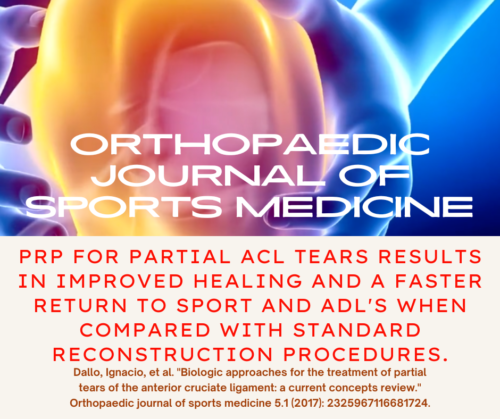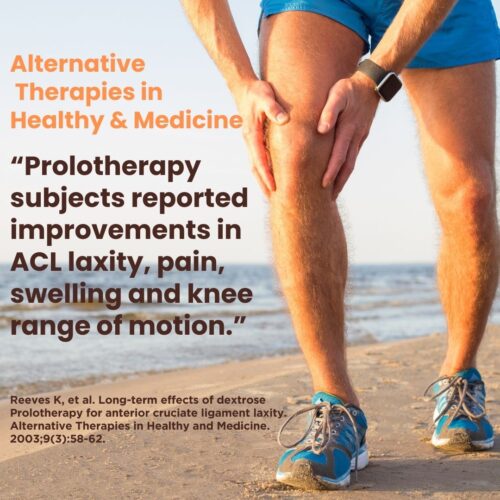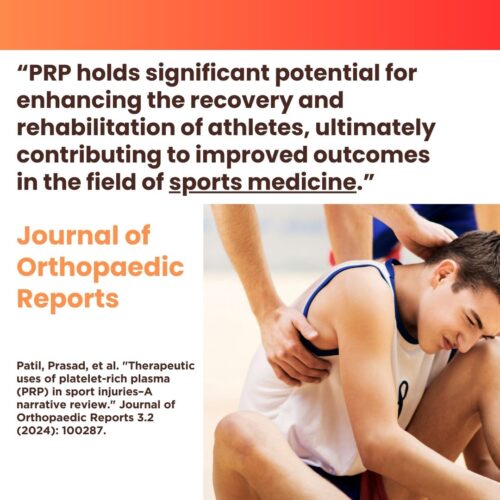
Anterior cruciate ligament (ACL) injuries in sports can occur due to trauma, improper training techniques, chronic overuse, and inadequate injury prevention measures. An ACL injury often means you feel your knee giving out. A “popping” noise may also be heard, and pain may be along the knee’s outside or back. Partial ACL tears may “heal” independently, but other problems can develop because of incomplete healing and other associated injuries. Complete healing and repair of the entire injury is essential, and comprehensive Regenerative Orthopedics are effective treatment options for ACL tear repair.
The anterior cruciate ligament (ACL) has traditionally been repaired surgically. Still, increased injuries have led to a higher need for repair and an increase in younger patients who may have complications with these surgical repairs. Because of these changes, alternatives to surgery are being sought. Regenerative techniques are being considered because they enhance the repair and regeneration of tissue and are excellent options for repairing ligament and tendon soft tissue structures.
Why is ACL repair important? Because the knee instability that occurs due to injury needs to be resolved, or further damage can happen to the other knee structures. Without resolution of the instability, the long-term complications of arthritis will also likely occur. Additionally, regenerating the injured ligament, rather than replacing it with grafts, can help boost the normal biomechanics of the knee. (1)
The ACL responds well to healing by regenerative treatments like Platelet Rich Plasma, which provides the needed fibrin-platelet clot and growth factors for repair. PRP is a rich source of growth factors, limiting inflammation and promoting tissue regeneration. (2) This platelet concentrate releases crucial growth factors that stimulate repair and collagen production. (3)
Regenerative Orthopedics is an effective alternative for difficult-to-treat younger patients with ACL injuries. Researchers in the Sports Medicine and Arthroscopy Review say, “Younger and more active patients benefit from regenerative approaches that encourage biological repair since they prevent complications provoked by the high stresses due to high physical demand over a prolonged time after classic replacement with synthetic materials.”(3)
At our OrthoRegen® clinic, we see patients who want to avoid surgery or those who have tried surgery and continue to have knee issues. Many young athletes choose surgery because they expect it to get them back in the game. Sometimes, it does, and sometimes, it fails. Physical Therapy also strengthens the leg, but unfortunately, it may not sufficiently stabilize the knee because the ligament cannot be repaired with PT. Therefore, a non-surgical solution to fix the instability is desired.
Other knee ligaments and/or the meniscus are likely damaged when an injury is significant enough to injure the ACL. That’s when comprehensive regenerative treatments shine. Why is that? Because comprehensive Regenerative Orthopedics treat the entire knee. All of the injured areas will be attended to for maximal healing results. On the other hand, ligament reconstruction, the usual management technique for significant ACL injuries, using replacement auto- or allografts, as noted earlier, has less than satisfactory outcomes, including instability that could progressively damage other knee structures, resulting in arthritis.
A November 2021 study in the Progress in Rehabilitation Medicine investigated whether student-athletes with anterior cruciate ligament (ACL) injuries who returned to sports without reconstruction could continue their sporting activities until the end of the season and whether there was an increase in secondary damage associated with knee instability. What did they find? Most athletes experienced their knees giving way and some experienced injury of their meniscus. Unfortunately, with ACL injury, instability occurs and the knee needs to be repaired. Non-surgical repair with Regenerative Orthopedics is an effective option.
Here’s what researchers from Brown University say, “Accelerated rehabilitation has made recovery from (ACL) surgery more predictable and shortened the timeline for return to play (from ACL reconstruction surgery). (However) Despite success with advancements in anterior cruciate ligament reconstructions, some athletes still fail to return to play.” There may be short-term results, but in the long term, stability of the knee becomes problematic. A solution that saves the biological ligament, like Regenerative Orthopedics can do, is the optimal way to go because it repairs the underlying instability problem and treats the whole knee, including the meniscus. (4)
Knee instability after ACL injury or even surgery will eventually lead to the breakdown of the knee structures. The instability needs to be addressed. The abnormal motion caused by the ACL injury needs to be repaired to prevent secondary pathology from the instability. Knee instability is a problem that needs to be solved, and no amount of surgery will address it. Regenerative Orthopedics does address knee instability.

Prolotherapy, one type of regenerative therapy, has been around for a very long time. The treatment has long been associated with being effective in treating joint instability due to ligament and/or damage. Over the years, research has proven its efficacy as a non-surgical treatment for joint and spine pain and injury. (5)
An ACL rupture increases anterior translation and rotational instability, leading to progressively worsening damage to the internal knee structures, including the meniscus and MCL. Prolotherapy addresses the central issue of ligament weakness and/or injury. Studies have demonstrated the development and growth of new ligamentous tissue in joints throughout the body using Prolotherapy. Reeves et al. tested the effects of Prolotherapy solutions on patients with ACL laxity. The subjects reported improvements in ACL laxity, pain, swelling, and knee range of motion. (5)
We also mentioned the research on the benefits of PRP earlier. That study and others show the benefits of biological augmentation, using PRP and stem cells, to improve healing and a faster return to sports and activities of daily living for those with partial ACL tears. (6)
It is important to note that these regenerative therapies cannot regrow an absent ligament if the tear is complete. However, they can restore strength and stability to a partial tear, ACL damage, and other knee soft tissue injuries. Additionally, for the highest success, the entire knee should be addressed and treated comprehensively to repair all damaged structures and prevent the development of arthritis.
“PRP stimulates human fibroblasts to produce growth factors, promoting collagen formation. PRP is synthesized using the athlete’s own blood.” “PRP is utilized in the treatment of soft tissue and bone injuries within the musculoskeletal system, particularly in the field of sports medicine. PRP, enriched with growth factors (GFs), is employed due to the frequent occurrence of tendon, ligament, and muscle injuries in sports that require prompt and effective interventions for the speedy recovery of athletes.” (7)

“PRP holds significant potential for enhancing the recovery and rehabilitation of athletes, ultimately contributing to improved outcomes in the field of sports medicine.” (7)
Depending on the severity of the injury, Prolotherapy alone may be recommended. If meniscus injury is present, Prolotherapy and PRP may be recommended. And, if more advanced degeneration and/or arthritis is evident, stem cell treatment may also be indicated.
Has surgery been recommended for an ACL repair? Are you seeking a non-surgical solution for an ACL injury? If so, we would be happy to discuss our Regenerative Orthopedic approaches and your options for ACL tear repair.
(1) Vavken P, Murray MM. Translational Studies in ACL repair. Tissue Eng Part A. 2009
(2) El-Sharkawy H, Kantarci A, Deady J, et al. Platelet-rich plasma: growth factors and pro- and anti-inflammatory properties. J Periodontol. 2007;78:661–669.
(3) Vavken, Patrick, and Martha M. Murray. “The potential for primary repair of the ACL.” Sports medicine and arthroscopy review 19.1 (2011): 44.
(4) Morris RC, Hulstyn MJ, Fleming BC, Owens BD, Fadale PD. Return to Play Following Anterior Cruciate Ligament Reconstruction. Clin Sports Med. 2016 Oct;35(4):655-68. doi: 10.1016/j.csm.2016.05.009. Epub 2016 Jun 22. PMID: 27543405.
(5) Reeves KD, Hassanein KM. Long-term effects of dextrose prolotherapy for anterior cruciate ligament laxity. Altern Ther Health Med. 2003 May-Jun;9(3):58-62. PMID: 12776476.
(6) Dallo I, Chahla J, Mitchell JJ, Pascual-Garrido C, Feagin JA, LaPrade RF. Biologic Approaches for the Treatment of Partial Tears of the Anterior Cruciate Ligament: A Current Concepts Review. Orthop J Sports Med. 2017 Jan 25;5(1):2325967116681724. doi: 10.1177/2325967116681724. PMID: 28210653; PMCID: PMC5298533.
(7) Patil, Prasad, et al. “Therapeutic uses of platelet-rich plasma (PRP) in sport injuries–A narrative review.” Journal of Orthopaedic Reports 3.2 (2024): 100287.